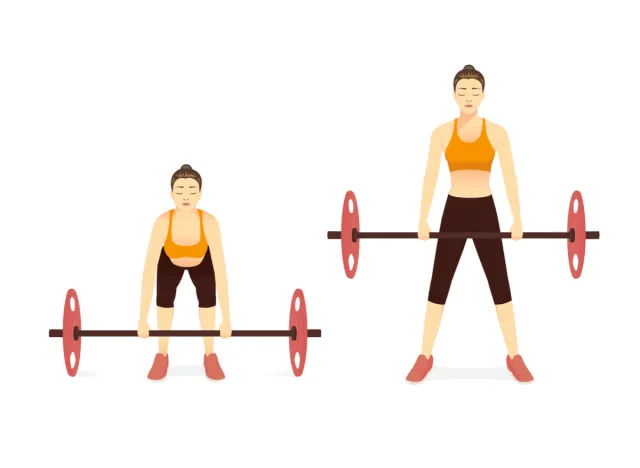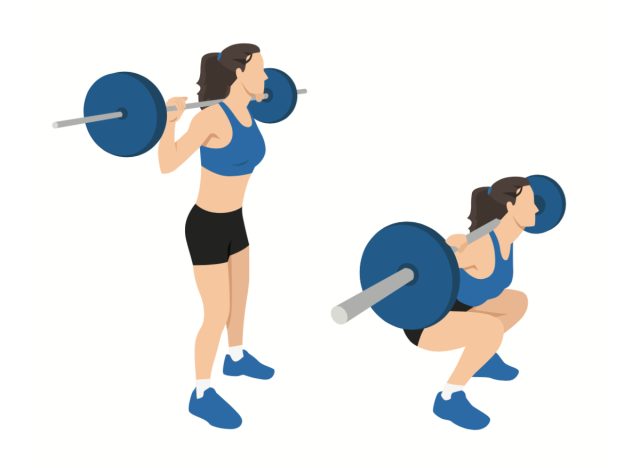Testing your lower-body strength is a crucial part of determining your fitness level and pinpointing areas of improvement. Building strong glutes and legs is key to staying mobile and stable during workouts and as you go about your daily tasks. That’s why we spoke with a fitness expert who outlines the best drills to test your lower-body strength. This way, you can establish a strong foundation that will help you power through your routine.
1RM Back Squat Test


“The best test for overall lower-body strength is the one rep max barbell back squat test,” explains Katie Kollath, ACE-CPT and co-founder of Barpath Fitness. This exercise will put your glute, quad, hamstring, calf, and core strength to the test.
How To Do It:
- Use a barbell with progressive weight increases to determine the maximum amount of weight you’re able to lift to perform one complete squat with solid form.
- Rest between each set to avoid fatigue impacting your results.
- Squatting one times your body weight falls under the category of “athletic and advanced strength.”
1RM Deadlift Test


“This will test your posterior chain strength, particularly in the hamstrings, glutes, and lower back,” Kollath tells us.
How To Do It:
- Use the same structure leading up to your one rep max as instructed above.
- Being able to deadlift 1.25 times or more of your body weight falls under the category of “athletic and advanced strength.”
Pistol Squat Test
A pistol squat requires you to lift one leg while balancing and squatting on your other leg—just make sure the foot of your squatting leg remains on the ground. This exercise engages your hip flexors, quads, glutes, calves, and tibialis.
“[The pistol squat] will test your strength on each limb,” Kollath points out. “[It] will also gauge your hip and ankle stability as well as hip flexor strength on the non-squatting [leg] as well.”
How To Do It:
- Complete as many pistol squats as possible on one leg.
- One to 5 reps on each leg is considered “advanced single-leg strength.”
Vertical Jump Test
The vertical jump test is a stellar indicator of power and explosivity in your legs, namely your glutes, quads, and calves.
How To Do It:
- Stand next to a marked wall.
- Jump as high as you’re able to.
- Measure the highest point you jump to with an outstretched arm.
- Complete a few practice jumps and note your best results.
- Males in the “advanced/athletic” category typically jump to 20 to 24 inches in height, while females in the same category usually hit 14 to 18 inches in height.
Sled Push Test


“This test is going to test the muscular endurance in your lower body,” Kollath explains. “[It] will assess overall lower-body power and strength, especially in the quads, glutes, and calves.”
How To Do It:
- Load a sled with weight.
- Push the sled across a distance as fast as you can, or measure the maximum amount of weight you’re able to push for a particular distance.
- Falling into the “advanced testing category” means you’re able to load the sled with 1 to 1.5 times your body weight and push the sled for 20 to 30 meters.
Hip Thrust Test


Strong glutes equals a strong lower body!
How To Do It:
- Load a barbell and progress toward a weight where you’re unable to perform the 4th rep.
- Position your upper back against the side of a stable workout bench and use a hip thrust pad.
- The barbell should rest on the tops of your thighs.
- Press your feet into the floor and extend your hips up until they’re parallel to the ground.
- Keep your chin tucked.
- Falling into the “athletic and advanced strength” category means you’re able to thrust 1.5 to 2 times your body weight.
Isometric Mid-Thigh Pull
“[The isometric mid thigh pull] tests maximal isometric force output of the lower body, which reflects overall lower-body strength,” Kollath tells us. “This is a maximal effort test that doesn’t require movement, reducing injury risk.”
How To Do It:
- Position a barbell at mid-thigh level.
- Pull upward as hard as you’re able to without actually lifting the barbell.
- Remain in this position as long as you’re able to before putting the barbell down.
- “Peak force” is generally achieved within 3 to 5 seconds. According to Kollath, most protocols recommend a 3-second max pull to achieve the highest force output.
- Two to 2.5 times your bodyweight falls into the “intermediate” category and 3 times your body weight is dubbed “advanced.”
“Since this test measures peak force rather than endurance, it’s key to focus on reaching maximum effort within a short timeframe,” explains Kollath. “There isn’t any weight lifted in the traditional sense. Instead, you pull against an immovable bar while force sensors or a force plate measure the amount of force you generate.”









